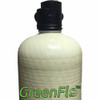Description
The GreenFlo™ LayneRT Upflow Arsenic 15 Filter System provides an effective solution for reducing arsenic levels in your home's drinking water, ensuring safety for you and your family. With cutting-edge LayneRT resin technology, this system efficiently tackles arsenic concentrations up to 300 ppb, making it a reliable choice for potable water.
Designed with convenience in mind, the upflow system operates without the need for electricity or backwashing. At a continuous flow rate of 5.6 GPM and peak flow capabilities of 11.25 GPM, this filter system seamlessly integrates into homes with moderate to high water usage, requiring minimal maintenance and low operating costs.
- Complete system includes a 10-inch x 54-inch resin tank and in/out control valve
- Bypass included for ease of installation
- Utilizes 1.5 cubic feet of LayneRT arsenic media for optimal results
- Simple DIY installation with detailed instructions
- No need for electricity or chemicals, making it eco-friendly
- Maintains a low upkeep cost with high durability and attrition resistance
- Passes Toxicity Characteristic Leaching Procedure (TCLP), ensuring safe waste disposal
- Perfect for homes with 2 bathrooms and 3-4 residents
Choose the GreenFlo™ LayneRT Upflow Arsenic 15 Filter System for a long-lasting, low-maintenance solution to arsenic contamination, protecting your water quality and your family's health.







